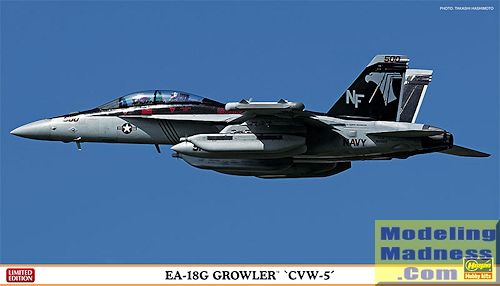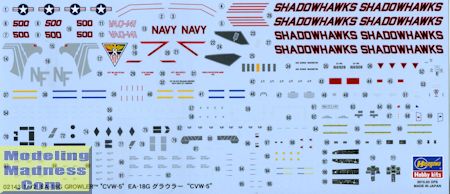
Hasegawa 1/72 EA-18G Growler 'CVW-5'
| KIT #: | 02143 |
| PRICE: |
2400 yen from
www.hlj.com
(about $20.00) 3000 yen SRP |
| DECALS: | One option |
| REVIEWER: | Scott Van Aken |
| NOTES: | Limited Edition: 2015 |

| HISTORY |
The first Growler for fleet use was officially accepted by VAQ-129 "Vikings" at NAS Whidbey Island, on 3 June 2008. The Navy planned to buy approximately 85 aircraft to equip 11 squadrons as of 2008. The EA-18G completed operational evaluation in late July 2009. The Growler was rated operationally effective and suitable for operational use. On 5 August 2009, EA-18G Growlers from Electronic Attack Squadron 129 (VAQ-129) and Electronic Attack Squadron 132 (VAQ-132) completed their first at-sea carrier-arrested landing aboard the USS Harry S. Truman (CVN-75). The first deployable EA-18G squadron is to be VAQ-132 "Scorpions", which reached operational status in October 2009. The first Growler operational deployment was announced on 17 February 2011.
In service, the EA-18's radio name during flight operations will be "Grizzly". The "Growler" nickname sounded too much like the EA-6B's "Prowler" name, so "Grizzly" will be used to avoid confusion. With the termination of the EB-52H standoff jammer, the Growler will become the sole remaining manned tactical jammer and Air Staff requirements director Maj. Gen. David Scott has indicated that the USAF will seek to provide electronic warfare officers to fly on US Navy Growlers, without providing funding to purchase additional aircraft. By May 2011, 48 Growlers had been delivered to the U.S. Navy.
The EA-18G was first used in combat during Operation Odyssey Dawn, enforcing the UN no-fly zone over Libya. Five EA-18Gs were redeployed from Iraq to support operations in Libya.
| THE KIT |
 In
common with the real aircraft, Hasegawa has taken their F-18F and added sprues
that will enable the modeler to build the electronic Hornet. Unlike the EA-6B,
the EA-18G does not have the mass of jamming pods nor the large fin mounted
antenna array. However, the system is basically the same. Does this mean that
the Growler isn't as useful as the Prowler? What do you think? One thing for
sure, the interface between the ALQ-99 system and the now lone system operator
has been upgraded, otherwise how else could one person perform the same
functions as three?
In
common with the real aircraft, Hasegawa has taken their F-18F and added sprues
that will enable the modeler to build the electronic Hornet. Unlike the EA-6B,
the EA-18G does not have the mass of jamming pods nor the large fin mounted
antenna array. However, the system is basically the same. Does this mean that
the Growler isn't as useful as the Prowler? What do you think? One thing for
sure, the interface between the ALQ-99 system and the now lone system operator
has been upgraded, otherwise how else could one person perform the same
functions as three?
So what you get in this kit is your standard F-18F with its adequate cockpit sporting decals for instruments and side console tops. A pair of rather plain bang seats is included so those into cockpits will want some resin replacements. Canopy can be displayed open or closed. The canopy also has a seam that will have to be removed. There is not one on the windscreen.
Now since this is based on the F, the modeler will need to fill in some panel lines, lop off some un needed items and do a bit of surgery to the wings as the G does not have the pronounced dogtooth on the leading edges. An insert is provided for when one cuts out the wing in that area. There are a number of additional holes to drill as well. As with the areas to be filled, the instructions provide information on just where these holes are to be put and the size of drill to use.
A bit of work will be needed on the wing tips as well when it comes to installing the ALQ-218 pods. The missile rail bits have to go before the pods will fit. The kit comes with three ALQ-99 jamming pods, one of which fits on the centerline. Each of these has a separate tail section with different bits for high and low band jammers. Also for under the wings are a pair of fuel tanks and rails for the AGM-88 HARM missiles. A pair of AIM-120s are provided to fit on the intakes.
 Instructions
are well done and there are a lot of notes so one has to pay attention to these
during the build. Markings are provided for the one airplane shown on the box
art from CVW-5 based in Japan. This VAQ-141 plane is the CAG bird with the upper
fuselage and tail fins painted in gloss black. The rest of the airframe is the
very boring FS 36320 over FS 36375, two shades that are so close to each other
as to often appear as one color in photos. It would have been nice to have
included a standard line bird as well, but such is not the case. The large decal
sheet is well done and one of Hasegawa's modern sheets which means the decals
will be very thin.
Instructions
are well done and there are a lot of notes so one has to pay attention to these
during the build. Markings are provided for the one airplane shown on the box
art from CVW-5 based in Japan. This VAQ-141 plane is the CAG bird with the upper
fuselage and tail fins painted in gloss black. The rest of the airframe is the
very boring FS 36320 over FS 36375, two shades that are so close to each other
as to often appear as one color in photos. It would have been nice to have
included a standard line bird as well, but such is not the case. The large decal
sheet is well done and one of Hasegawa's modern sheets which means the decals
will be very thin.
| CONCLUSIONS |
Due to all the modifications required, this is probably not a good kit for a beginner. The Hasegawa Super Bugs are actually kits that need care in construction, due to the number of small parts and the engineering that went into molding the kit. Such is the way the hobby goes when one is doing multiple variants from a base set of molds. I have seen this kit built up and with care, it can be turned into a superb model. One thing for sure, as more and more units work up on the type, there will be more and more limited editions being produced for the fans.
| REFERENCES |
http://en.wikipedia.org/wiki/Boeing_EA-18G_Growler
April 2015
Thanks to www.hlj.com
for the preview kit. Get yours
at this link.
If you would like your product reviewed fairly and fairly
quickly, please
contact
the editor
or see other details in the
Note to
Contributors.